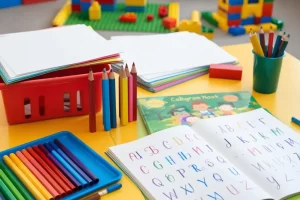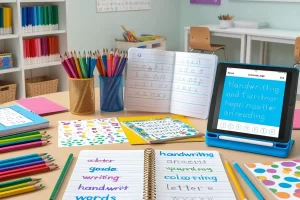Have you ever noticed how remembering something handwritten is easier than something just read? Studies show that the act of writing words manually activates brain areas related to memory and learning. For children in elementary education, this practice can make a big difference when interpreting texts, helping them absorb information more effectively and develop more structured thinking.
When a child writes a word by hand, they are not only training motor coordination but also strengthening their comprehension ability. The process of forming letters manually activates the brain more intensely than simply typing or passive reading, making content retention more effective.
Let’s explore how manual writing can be a great ally in developing text interpretation in elementary education. You will discover practical strategies, activities, and insights that show how this skill can transform the way children absorb and understand texts.
1. Manual Writing and Information Processing
The act of writing words manually involves much more than simply tracing letters on paper. When a child writes by hand, their brain activates various areas responsible for memory, attention, and language processing. This movement creates a deep connection between what is written and what is understood, strengthening information retention and facilitating learning. Unlike passive reading, handwriting requires greater cognitive effort, making the experience more meaningful and lasting.
Compared to typing, the act of manually forming letters has a much more expressive effect on textual assimilation. When typing on a keyboard, a child performs repetitive mechanical movements without needing to process each letter individually.
However, when forming words on paper, they need to slow down, pay attention to details, and organize their thoughts before writing them down, which enhances their comprehension ability. This difference makes manual writing a powerful tool for developing text interpretation skills.
Moreover, regular handwriting practice improves reading fluency and strengthens word recognition. By drawing each letter, the child trains their visual perception, better understanding the shapes, spacing, and sentence structure. This exercise directly contributes to more active and engaging reading, helping students become more attentive and critical readers.
2. How Handwriting Practice Influences Reading and Text Interpretation
Constant handwriting practice has a profound effect on how children absorb the content of texts. The process of writing by hand is slower and more reflective, allowing students to internalize information better.
Unlike fast reading or automatic typing, handwriting requires children to focus on each word, which favors more effective content absorption. This slower pace allows for greater reflection on what is being read, helping to solidify understanding and memory of the text.
Here’s how handwriting practice positively impacts reading and interpretation:
Benefits of a Slower Process in Text Assimilation
Handwriting demands more attention and a slower pace, aiding in content retention.
The pause in the transcription process allows for deeper reflection on the text’s meaning, facilitating understanding.
How the Habit of Transcription Improves Text Structure Perception
Manual transcription helps children identify important linguistic patterns, such as sentence construction and word connections.
This practice makes students more capable of understanding complex sentences and structuring their own interpretations.
Recognition of Punctuation, Spacing, and Text Coherence
Attention to graphical details, such as punctuation and spacing, improves reading fluency and interpretation.
This visual training reinforces the ability to connect parts of the text and understand its meaning more accurately.
Focusing on these graphical and linguistic details not only facilitates reading but also enhances critical interpretation, helping children become more attentive and analytical when understanding what they read.
3. Strategies to Integrate Writing Exercises into Text Comprehension Instruction
Integrating handwriting exercises into text comprehension instruction is an effective way to reinforce content assimilation and improve student interpretation. Writing by hand not only strengthens information retention but also helps develop critical reading skills. Below are some strategies that connect handwriting practice with text comprehension:
Slow and Reflective Writing Practices
Encourage students to write more slowly and carefully, reflecting on each word and its meaning.
This practice helps internalize content as it requires students to think about what they are writing, making the writing process a continuous reflection on the meaning of the text.
Active Copying of Text Passages
Encourage students to actively copy passages of texts they are studying, paying attention to the meaning of each sentence as they write.
This method reinforces content assimilation because when copying, the child revisits the information multiple times, strengthening memory and facilitating text comprehension.
Rewriting with Word Variation
Propose that students rewrite parts of the text, using synonyms or changing sentence structures, to improve their vocabulary and comprehension.
This strategy stimulates reflection on the content, promoting deeper interpretation and expanding students’ vocabulary, making them more critical readers capable of understanding more complex texts.
4. Practical Activities to Enhance Reading through Manual Writing
There are several practical activities that can be used to enhance reading through manual writing, integrating writing into the process of text interpretation and comprehension. These activities are excellent tools for encouraging students to reflect on the content they read, helping them assimilate and organize information effectively. Here are some activities that can be easily implemented in elementary education:
Handwritten Summaries
Asking students to write handwritten summaries after reading a text can be an excellent way to reinforce comprehension.
The act of synthesizing the main ideas of the text and putting them into their own words requires students to deeply understand the content. Constant practice with handwritten summaries improves the ability to absorb and retain the information read.
Dictation with Interpretation
Dictation, when combined with interpretation, is an activity that combines listening, writing, and critical analysis.
During dictation, students not only write what they hear but also need to understand the context of what is being said. This requires attention to the content and promotes reflection on words and their relationships within the text, strengthening both writing and comprehension skills.
Formulating Questions about the Text
Asking students to formulate questions about the content they read is a great strategy to stimulate material assimilation.
This practice helps them focus on the most important points of the text and develop critical skills, as they need to think about the content in a deeper way. Additionally, by answering their own questions or those of their peers, students consolidate the knowledge they’ve acquired.
5. Handwriting as a Tool for Developing Critical Interpretation
Handwriting goes beyond being a simple tool for recording information; it can be a powerful ally in developing critical interpretation. By writing by hand, students are encouraged to think more deeply about the content they read, analyzing it from various perspectives. This active process of thinking and recording what was read strengthens the ability to evaluate and interpret texts more analytically, helping them understand the author’s intentions and underlying messages.
The Relationship Between Writing and Reflection on Read Content
Writing involves an active mental process that forces the student to slow down and think about what they are reading, allowing for more detailed reflection.
This pause in the writing process encourages students to engage more critically with the text, analyzing the ideas presented and reflecting on their own interpretations. This facilitates critical analysis and helps build a more profound understanding of the content.
Paraphrasing and Rewriting Exercises
Asking students to rewrite parts of the text in their own words is an excellent strategy for working on critical interpretation.
Paraphrasing requires them to deeply understand the meaning of what was read in order to convey the idea clearly and accessibly. This practice strengthens their ability to comprehend the text on multiple levels and express ideas in a personal and unique way.
The Impact of Handwriting on Argumentation
By elaborating responses and arguments through handwriting, students are encouraged to structure their ideas more logically and coherently.
Handwriting allows for responses to be thought out and reviewed before being recorded, resulting in more complete and organized arguments. This active process strengthens argumentative skills and the ability to construct more articulate and well-supported responses.
Final Considerations
Handwriting has proven to be a key ally in strengthening text interpretation because it promotes a direct connection between the brain and the content being read. When writing by hand, children not only record words but also internalize information, making the reading process more efficient and profound. The practice of handwriting goes beyond writing; it transforms the way students understand, analyze, and connect with texts, favoring a more critical and reflective reading approach.
It is essential to integrate handwriting practices into reading instruction because they offer unique benefits that typing, for example, cannot provide. By including activities that encourage manual writing, such as summaries, paraphrasing, and active copying, reading and interpretation skills can be dynamically and effectively strengthened. These exercises allow students to develop a more solid understanding and greater argumentative capacity.
Finally, it is important for teachers and parents to encourage the use of handwriting as an educational tool, recognizing its positive impact on cognitive development and reading comprehension. By valuing this practice, we are offering students a powerful tool to enhance their reading skills, making them more critical, capable readers ready for the educational challenges ahead.
If you believe in the power of handwriting to strengthen text comprehension, why not start applying it in everyday life with your students or children? Share your experiences in the comments and help spread this transformative practice in education! 🚀📖✍️




